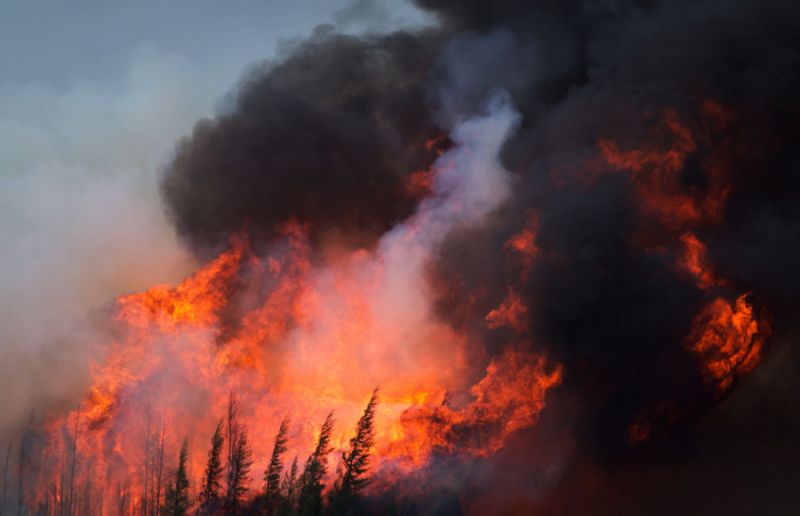

(Bloomberg) — On a tower in the Brazilian rain forest, a sentinel scans the horizon for the first signs of fire.
Only these eyes aren’t human. They don’t blink or take breaks, and guided by artificial intelligence they can tell the difference between a dust cloud, an insect swarm and a plume of smoke that demands quick attention. In Brazil, the devices help keep mining giant Vale SA working, and protect trees for pulp and paper producer Suzano SA.
The equipment includes optical and thermal cameras, as well as spectrometric systems that identify the chemical makeup of substances. By linking them to artificial intelligence, a small Portugal-based company working with IBM Corp. believes it can help tame the often unpredictable affects of climate change. Others are using AI to predict dangerous hail storms, and studying how it can help find victims in bad weather.
“Climate change is dramatically changing the way we look at this problem of wildfires,” said Vasco Correia, chief business officer at Compta Emerging Business Solutions, which builds the devices. “Two years ago we started looking to artificial intelligence and machine learning because we believe those can be game changers.”
In 2019, weather and climate events killed more than 4,000 people worldwide, and caused around $42 billion in insured losses, according to the insurer Munich Re. Compta’s goal is to limit losses with warnings that can help keep a small blaze from becoming a conflagration.
The Compta system was first used in Brazil in a pilot program designed to test its effectiveness, but now is “available globally and operational,” Correia said by telephone.
The company recently opened an office in California, which had its deadliest wildfire last year when a blaze blamed on PG&E Corp. power lines consumed the town of Paradise, killing 85. Liabilities from that fire helped push the utility into bankruptcy in January.
Along with analyzing the data from on site, the device’s artificial intelligence will weigh similar events captured by the system over time. It will also use IBM’s Watson supercomputer to visually evaluate what it sees and forecasts from its Weather Company to predict how the fire might spread.
“The landscape of wildfires and how they ignite and how they evolve today is much different from what we had in past decades,’’ Correia said. “The fire seasons are two months longer than they were in the past decades, and wild fires today are burning six times the land area than they did before and lasting five times longer.’’
Wildfires are just one of many threats as extreme weather costs keep rising.
The trail of destruction through the first half of this year included flooded farm fields across the Midwest and carnage along the African coast from Cyclone Idai, which killed 1,013 people, according to Munich Re.
One threat artificial intelligence could help humans prepare better for is hail, said David Gagne, a machine learning scientist at the National Center for Atmospheric Research in Boulder, Colorado. Since 2008, hail and severe thunderstorms damage has jumped to $19 billion a year adjusted for inflation and has stayed there since.
Gagne said the group is researching a tool that the National Weather Service can use to help meteorologists better predict where and when hail is going to happen a day in advance. So far the hail program has improved accuracy by 10%, and there is work underway to test it real time within the weather service.
Identifying Storm Types
A surprising outcome is that the program has taught itself to recognize between supercell storms, which produce a lot of hail, from linear and pulse storms, which are less destructive. “You get a storm type classifier for free,” Gagne said. “It just kind of figured out storm type by looking at all the features of the storms. It is a really neat result.”
Artificial intelligence and machine learning programs are being used in other weather and climate related applications as well. For instance, defense and aerospace giant Raytheon Co. has begun to explore AI’s use to coordinate rescues in the aftermath of disasters, said Todd Probert, a vice president with the company.
“Imagine that the National Guard could quickly pinpoint survivors hidden inside literally the terabyte satellite data that is coming down,” Probert said. “What if those fire responders could make sense out of literally the thousands of texts and tweets and calls desperately seeking emergency services and vector into where the most critical need was.”
Humans do this by pouring over images. Imagine a computerized tool that searches for flooding, he said, adding, That’s a pretty good first order.”
Raytheon has been working with the National Guard to pull data off of Facebook to pinpoint people who need help in the aftermath of several recent storms. But these have been episodic and there aren’t machine learning tools on the back end to create a product rescue crews could use in all situations.
“The whole game here is about putting the data to work for us,” Probert said.
To contact the reporter on this story: Brian K. Sullivan in Boston at [email protected]
To contact the editors responsible for this story: Tina Davis at [email protected], Reg Gale, James Attwood
<p class="canvas-atom canvas-text Mb(1.0em) Mb(0)–sm Mt(0.8em)–sm" type="text" content="For more articles like this, please visit us at bloomberg.com” data-reactid=”44″>For more articles like this, please visit us at bloomberg.com
©2019 Bloomberg L.P.






